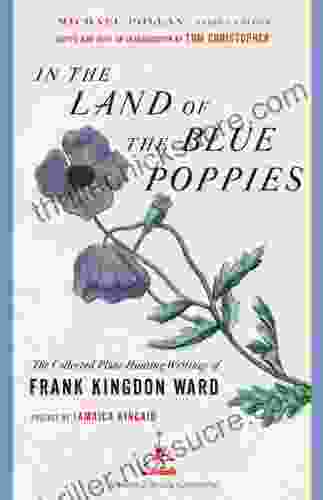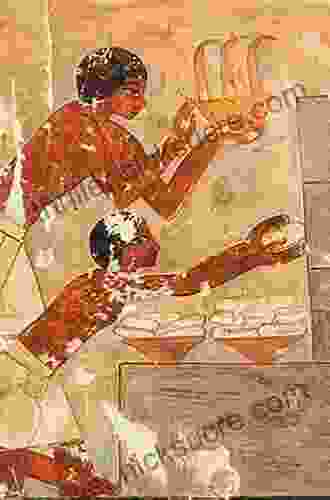The Tears of Ra: Beekeeping in Ancient Egypt

In the sun-drenched Nile Valley, amidst the colossal temples and towering pyramids, there existed a thriving civilization that held a profound reverence for bees. The ancient Egyptians believed that bees were messengers of the gods, and their sweet nectar—known as the "tears of Ra"—held a mystical significance. From the pharaohs to the common people, beekeeping played a vital role in Egyptian society, providing sustenance, medicine, and religious symbolism.
Bees: Messengers of the Gods
In Egyptian mythology, bees were associated with the sun god Ra. It was believed that Ra's tears, which fell from the sky as golden drops, gave rise to bees and their honey. Bees were seen as intermediaries between the gods and the people, carrying messages from the heavens. The hieroglyph for "bee" even resembled a drop of honey, symbolizing its sacred connection to the divine.
4.6 out of 5
| Language | : | English |
| File size | : | 21149 KB |
| Text-to-Speech | : | Enabled |
| Screen Reader | : | Supported |
| Enhanced typesetting | : | Enabled |
| Word Wise | : | Enabled |
| Print length | : | 160 pages |
| Lending | : | Enabled |
The Honeycomb: A Symbol of Creation
The honeycomb held a special place in ancient Egyptian thought. Its hexagonal structure was considered a symbol of order and creation. It was believed that the gods used honeycomb as a template for organizing the universe. The honeycomb's intricate design also inspired artists and architects, who incorporated honeycomb patterns in temples and tombs.
Beekeeping Practices
Ancient Egyptians practiced beekeeping in a sophisticated manner. They crafted specialized hives made of terracotta or woven reeds, providing a sheltered environment for the bees to thrive. Skilled beekeepers used smoke to calm the bees and collected honey using long, thin straws. Honey was stored in jars and sealed with beeswax, which acted as a natural preservative.
Honey: A Versatile Resource
Honey was a versatile resource in ancient Egypt. It was a primary sweetener, used to make cakes, pastries, and drinks. Its medicinal properties were also renowned, and it was used to treat wounds, infections, and digestive disorders. Honey was believed to have antibacterial and anti-inflammatory properties, making it an effective remedy for various ailments.
Beeswax: A Valuable Commodity
Beeswax was another important product of beekeeping. It was used to make candles, which provided light and warmth in homes and temples. Beeswax was also used in cosmetics, pottery, and embalming. Its water-resistant properties made it an excellent material for sealing jars and containers.
Religious Significance
Bees and honey held a profound religious significance in ancient Egypt. Honey was used to offer libations to the gods and to sweeten the offerings made in temples. Bees were considered sacred creatures, and beekeepers were often priests or other religious officials. The pharaoh himself was sometimes depicted as a beekeeper, symbolizing his role as the protector and provider for his people.
Bees and the Afterlife
Bees and honey played an important role in Egyptian beliefs about the afterlife. The Book of the Dead, an ancient Egyptian funerary text, mentions bees as guardians of the afterlife. It was believed that bees would guide the deceased through the underworld and escort them to the Fields of Aaru, a paradise for the righteous.
Modern Legacy
The legacy of ancient Egyptian beekeeping continues to inspire modern practices. Contemporary beekeepers still use terracotta hives similar to those used in ancient times. Honey and beeswax remain valuable products around the world, and their medicinal properties are still recognized. The fascination with bees and their enigmatic nature continues to captivate us, reminding us of the deep connection between humanity and these extraordinary creatures.
The ancient Egyptians held bees in high esteem, recognizing their vital role in nature and their sacred association with the gods. Beekeeping flourished in the Nile Valley, providing sustenance, medicine, and religious symbolism. From the "tears of Ra" to the intricate designs of the honeycomb, bees played an integral part in the life and culture of ancient Egypt. Their legacy continues to inspire us today, reminding us of the enduring relationship between humans and the natural world.
4.6 out of 5
| Language | : | English |
| File size | : | 21149 KB |
| Text-to-Speech | : | Enabled |
| Screen Reader | : | Supported |
| Enhanced typesetting | : | Enabled |
| Word Wise | : | Enabled |
| Print length | : | 160 pages |
| Lending | : | Enabled |
Do you want to contribute by writing guest posts on this blog?
Please contact us and send us a resume of previous articles that you have written.
 Fiction
Fiction Non Fiction
Non Fiction Romance
Romance Mystery
Mystery Thriller
Thriller SciFi
SciFi Fantasy
Fantasy Horror
Horror Biography
Biography Selfhelp
Selfhelp Business
Business History
History Classics
Classics Poetry
Poetry Childrens
Childrens Young Adult
Young Adult Educational
Educational Cooking
Cooking Travel
Travel Lifestyle
Lifestyle Spirituality
Spirituality Health
Health Fitness
Fitness Technology
Technology Science
Science Arts
Arts Crafts
Crafts DIY
DIY Gardening
Gardening Petcare
Petcare Nate Allen
Nate Allen David Levithan
David Levithan Lee Alan Dugatkin
Lee Alan Dugatkin Jennifer Block
Jennifer Block Ron Lieber
Ron Lieber Lily Raff Mccaulou
Lily Raff Mccaulou Fritjof Capra
Fritjof Capra Jimmie Holland
Jimmie Holland Scott Hawthorn
Scott Hawthorn Lisa Druxman
Lisa Druxman Brian Gewirtz
Brian Gewirtz Laura A Jana
Laura A Jana Carol Dawson
Carol Dawson J C Cervantes
J C Cervantes Ronald M Rapee
Ronald M Rapee Emilee Day
Emilee Day Emily Lauren Dick
Emily Lauren Dick Jean Nayar
Jean Nayar Deepak Chopra
Deepak Chopra Kate Mcmillan
Kate Mcmillan Bryan Berard
Bryan Berard Leigh Pearson
Leigh Pearson Varg Freeborn
Varg Freeborn Charlie Francis
Charlie Francis Jez Cajiao
Jez Cajiao Piero Ferrucci
Piero Ferrucci Grete Waitz
Grete Waitz Ned Mcintosh
Ned Mcintosh Tadashi Yoshimura
Tadashi Yoshimura Bernard Darwin
Bernard Darwin Dr Nanhee Byrnes
Dr Nanhee Byrnes Dr Alison Dibarto Goggin
Dr Alison Dibarto Goggin Howtodressage
Howtodressage Breanna Hayse
Breanna Hayse Krishna Godhania
Krishna Godhania Michael Mason
Michael Mason John Cooper
John Cooper Stuart Woods
Stuart Woods Steven W Vannoy
Steven W Vannoy Matt Davids
Matt Davids Richard Hingley
Richard Hingley Steven Shapin
Steven Shapin Steve Oakes
Steve Oakes Dawna Markova
Dawna Markova Joanne M Flood
Joanne M Flood Dinesh Kumar Goyal
Dinesh Kumar Goyal Colette Harris
Colette Harris Daniel Bagur
Daniel Bagur Santari Green
Santari Green David Cannon
David Cannon Brittany Cavallaro
Brittany Cavallaro Daniel Dell Uomo
Daniel Dell Uomo Jason Brick
Jason Brick Ksenia K
Ksenia K Julie Cangialosi
Julie Cangialosi T D Wilson
T D Wilson Scott Haines
Scott Haines Mark William
Mark William M A Hayat
M A Hayat Kenneth Paul Rosenberg
Kenneth Paul Rosenberg Danny Staple
Danny Staple J Wayne Fears
J Wayne Fears Sriman Sharma
Sriman Sharma Renee Jain
Renee Jain Pedro Sarmiento De Gamboa
Pedro Sarmiento De Gamboa Mary Heffernan
Mary Heffernan Hal R Varian
Hal R Varian Tim Dunn
Tim Dunn Jackie Freeman
Jackie Freeman Jp Kriya
Jp Kriya John Bradshaw
John Bradshaw Mark Seemann
Mark Seemann Khalid Khashoggi
Khalid Khashoggi Alex Horne
Alex Horne J R Mathews
J R Mathews Colleen Doyle Bryant
Colleen Doyle Bryant Mark Johnston
Mark Johnston Grace Friedman
Grace Friedman Eduardo Montano
Eduardo Montano Judith A Owens
Judith A Owens Zigzag English
Zigzag English Rick J Scavetta
Rick J Scavetta Kathleen Taylor
Kathleen Taylor Mitchel P Roth
Mitchel P Roth Jim White
Jim White Christopher Ketcham
Christopher Ketcham Rachel Mcgrath
Rachel Mcgrath F R Lifestyle
F R Lifestyle Doug Peacock
Doug Peacock Bruce Lee
Bruce Lee Chuck Callaway
Chuck Callaway Harry Vardon
Harry Vardon Leslie Valiant
Leslie Valiant Dava Sobel
Dava Sobel Laurie A Watkins
Laurie A Watkins Sandra M Nettina
Sandra M Nettina Trish Kuffner
Trish Kuffner Megan Smolenyak
Megan Smolenyak Kevin Alexander
Kevin Alexander Rahul Jandial
Rahul Jandial Bobbi Conner
Bobbi Conner Pat Manocchia
Pat Manocchia Mary Morrison
Mary Morrison Gene Kritsky
Gene Kritsky Cecilia Twinch
Cecilia Twinch Nehemia Gordon
Nehemia Gordon Joanna Philbin
Joanna Philbin Ryan M Cleckner
Ryan M Cleckner David Hackett Fischer
David Hackett Fischer David Hoffman
David Hoffman Jessica Minahan
Jessica Minahan Claudia M Gold
Claudia M Gold James D Tabor
James D Tabor Elsevier
Elsevier Dave Cutcher
Dave Cutcher Jonti Marks
Jonti Marks Damien Cox
Damien Cox Tom M Apostol
Tom M Apostol Eric Michael
Eric Michael James M Jones
James M Jones Lisa Leake
Lisa Leake Gerald L Schroeder
Gerald L Schroeder Shannon Warden
Shannon Warden Kelle James
Kelle James Esther Hicks
Esther Hicks Sara Elliott Price
Sara Elliott Price Susan F Paterno
Susan F Paterno Shayla Black
Shayla Black Michael Omi
Michael Omi Jackson T Markbrown
Jackson T Markbrown Jeremy J Baumberg
Jeremy J Baumberg Jeanne Ellis Ormrod
Jeanne Ellis Ormrod Mitt Romney
Mitt Romney John Connelly
John Connelly Martin Wells
Martin Wells Henry Worsley
Henry Worsley E L Konigsburg
E L Konigsburg Geoffrey Simpson
Geoffrey Simpson Harry Bauld
Harry Bauld Einat L K
Einat L K Joseph Ewing
Joseph Ewing Patti Henry
Patti Henry Scott Zimmerman
Scott Zimmerman Harold Gatty
Harold Gatty Samuel Greenberg
Samuel Greenberg Roach Mary
Roach Mary Keith Ryan Cartwright
Keith Ryan Cartwright James Zug
James Zug Kerry Mcdonald
Kerry Mcdonald Grace Mariana Rector
Grace Mariana Rector Ivan Savov
Ivan Savov Patty Wipfler
Patty Wipfler Robert Wright
Robert Wright Rob Vollman
Rob Vollman Sunil Tanna
Sunil Tanna Jameswesley Rawles
Jameswesley Rawles Elizabeth Davis
Elizabeth Davis 1st Ed 2018 Edition Kindle Edition
1st Ed 2018 Edition Kindle Edition Stephanie Perkins
Stephanie Perkins James Dean
James Dean Steve Schwartz
Steve Schwartz Marguerite Henry
Marguerite Henry Deborah Shouse
Deborah Shouse Miguel Crespo
Miguel Crespo Phil Williams
Phil Williams Luis Preto
Luis Preto Steven Emanuel
Steven Emanuel Tom Cunliffe
Tom Cunliffe David Schoem
David Schoem Derek Blasberg
Derek Blasberg Richard Post
Richard Post Helen Zee
Helen Zee Brogan Steele
Brogan Steele Carol Newell
Carol Newell Kusha Karvandi
Kusha Karvandi Robin Dunbar
Robin Dunbar Diana J Mason
Diana J Mason Bruce A Fenderson
Bruce A Fenderson D Enette Larson Meyer
D Enette Larson Meyer Eric C Lindstrom
Eric C Lindstrom Paula Span
Paula Span Steven Hugg
Steven Hugg Mary Strand
Mary Strand Steve Williams
Steve Williams Peggy Tharpe
Peggy Tharpe Dr Faith G Harper
Dr Faith G Harper Marco Polo
Marco Polo Janice L Raymond
Janice L Raymond Megan Whalen Turner
Megan Whalen Turner Jd Tanner
Jd Tanner Don Brown
Don Brown Richard Bass
Richard Bass Steven Cross
Steven Cross Milne Cc Pocock
Milne Cc Pocock Catherine Shainberg
Catherine Shainberg Penny Alexander
Penny Alexander Jeremy Bradstreet
Jeremy Bradstreet Brian Herne
Brian Herne Melanie Challenger
Melanie Challenger Joyce Harper
Joyce Harper Alan D Moore
Alan D Moore Paul Simpson
Paul Simpson Xavier Wells
Xavier Wells Gerald R Allen
Gerald R Allen Nora Roberts
Nora Roberts Jacqueline Houtman
Jacqueline Houtman James O Prochaska
James O Prochaska Karen Wilkinson
Karen Wilkinson Eze Ugbor
Eze Ugbor Porter Shimer
Porter Shimer Heather Rose
Heather Rose Worth Books
Worth Books Lori Lyons
Lori Lyons Joel Ingersoll
Joel Ingersoll John Mclachlan
John Mclachlan Garrett Redfield
Garrett Redfield Ilchi Lee
Ilchi Lee Chase Hassen
Chase Hassen Dusan Petkovic
Dusan Petkovic Sue Wieger
Sue Wieger E G Richards
E G Richards Kaylene Yoder
Kaylene Yoder Masaaki Kijima
Masaaki Kijima Rosalyn Sheehy
Rosalyn Sheehy Brian W Kernighan
Brian W Kernighan Nancy Boyd Franklin
Nancy Boyd Franklin John A Fortunato
John A Fortunato Collins O Onwe
Collins O Onwe Inge Bell
Inge Bell Karl F Kuhn
Karl F Kuhn Celina Grace
Celina Grace Ursula Hackett
Ursula Hackett William Shakespeare
William Shakespeare Steven Verrier
Steven Verrier Adrienne Onofri
Adrienne Onofri Kicki Hansard
Kicki Hansard Mark Lazerus
Mark Lazerus Jacob Boehme
Jacob Boehme Gerson S Sher
Gerson S Sher Diane Ravitch
Diane Ravitch Sarah Lamb
Sarah Lamb John Major Jenkins
John Major Jenkins Lucia Guglielminetti
Lucia Guglielminetti Maria Sharapova
Maria Sharapova Joe Grant
Joe Grant Janae M Robinson
Janae M Robinson Eric R Dodge
Eric R Dodge S Connolly
S Connolly Iwan Rhys Morus
Iwan Rhys Morus Cpt Exam Prep Team
Cpt Exam Prep Team Joyce Bas
Joyce Bas Mariana Monteiro
Mariana Monteiro John Wesson
John Wesson Elwyn Hartley Edwards
Elwyn Hartley Edwards Jp Lepeley
Jp Lepeley Warren Hansen
Warren Hansen Nadim Saad
Nadim Saad Sam Sorbo
Sam Sorbo Emil Frlez
Emil Frlez Martin Odersky
Martin Odersky Ann Imig
Ann Imig Malcolm Hebron
Malcolm Hebron Natalia Ilyin
Natalia Ilyin Martin A Lee
Martin A Lee Ted Franklin Belue
Ted Franklin Belue Estelle Dautry
Estelle Dautry Brett Cohen
Brett Cohen Paul Weamer
Paul Weamer David M Ewalt
David M Ewalt Pittacus Lore
Pittacus Lore Richard Kasper
Richard Kasper David Mcclung
David Mcclung Brian Kilmeade
Brian Kilmeade David Sinclair
David Sinclair Jane Albert
Jane Albert Caitlyn Dare
Caitlyn Dare Rory D Nelson
Rory D Nelson John M Taylor
John M Taylor Calvin Trillin
Calvin Trillin Lindsey Schlessinger
Lindsey Schlessinger Jeannie Burlowski
Jeannie Burlowski Michael O Emerson
Michael O Emerson Kazumi Tabata
Kazumi Tabata Maurice Herzog
Maurice Herzog Jason Sandy
Jason Sandy Mark J Ferrari
Mark J Ferrari Mohammad F Anwar
Mohammad F Anwar Kira Breed Wrisley
Kira Breed Wrisley Patricia Wooster
Patricia Wooster Rich Cohen
Rich Cohen Inger Mewburn
Inger Mewburn John Mcenroe
John Mcenroe Paula Brackston
Paula Brackston Jodi Aman
Jodi Aman Ethan Bezos
Ethan Bezos David Barrett
David Barrett Lucas Chancel
Lucas Chancel Rich Osthoff
Rich Osthoff Clayton King
Clayton King Nibedit Dey
Nibedit Dey Carol Walters
Carol Walters Brian Everitt
Brian Everitt Rachel Love Nuwer
Rachel Love Nuwer David Jason
David Jason Tobe Melora Correal
Tobe Melora Correal Thao Te
Thao Te Wilborn Hampton
Wilborn Hampton Michael A Tompkins
Michael A Tompkins Peter Wacht
Peter Wacht Mark Howard
Mark Howard Elliot Davis
Elliot Davis Joanna Faber
Joanna Faber Carol Kaesuk Yoon
Carol Kaesuk Yoon Peter Allison
Peter Allison Phillip Stephen Schulz
Phillip Stephen Schulz David Flanagan
David Flanagan Debra Fine
Debra Fine James Miller
James Miller Gjoko Muratovski
Gjoko Muratovski Vincent W Davis
Vincent W Davis Douglas R Hofstadter
Douglas R Hofstadter Cassandra Overby
Cassandra Overby Steven Trustrum
Steven Trustrum Stephanie Sarkis
Stephanie Sarkis Michael Sullivan Iii
Michael Sullivan Iii Jhenah Telyndru
Jhenah Telyndru Loan Le
Loan Le Charles Wilson
Charles Wilson Joan Nathan
Joan Nathan Sean Michael Wilson
Sean Michael Wilson Mike Weatherstone
Mike Weatherstone Peggy Kaye
Peggy Kaye Chukwuma Eleodimuo
Chukwuma Eleodimuo Steve Bromley
Steve Bromley Keith Foskett
Keith Foskett Sarah Kleck
Sarah Kleck Bret Stetka
Bret Stetka Don L Gates
Don L Gates Karen Ward Mahar
Karen Ward Mahar Murray Shukyn
Murray Shukyn Melinda Tankard Reist
Melinda Tankard Reist Kindle Edition
Kindle Edition John D Couch
John D Couch Kalynn Bayron
Kalynn Bayron Gustav Meyrink
Gustav Meyrink Chuanwei Li
Chuanwei Li Grace Mccready
Grace Mccready Clyde Soles
Clyde Soles Florence Weiser
Florence Weiser Arthur Scott Bailey
Arthur Scott Bailey Wil Fleming
Wil Fleming J R Harris
J R Harris Kathleen Cushman
Kathleen Cushman Lukas M Verburgt
Lukas M Verburgt Samantha Michaels
Samantha Michaels Kevin Marx
Kevin Marx Edith Hall
Edith Hall Courtney Macavinta
Courtney Macavinta Lucy Hopping
Lucy Hopping Nachole Johnson
Nachole Johnson Scott Reed
Scott Reed William Trubridge
William Trubridge Sara Gaviria
Sara Gaviria Christopher Clarey
Christopher Clarey D S Malik
D S Malik Richard Blais
Richard Blais Mike Eastman
Mike Eastman Jaime Flowers
Jaime Flowers William Albert Robinson
William Albert Robinson Jeanne Flavin
Jeanne Flavin Matt Wastradowski
Matt Wastradowski Stephen Hawking
Stephen Hawking Brion Toss
Brion Toss Gabriel F Federico
Gabriel F Federico Cheryl Diamond
Cheryl Diamond Kate S Martin
Kate S Martin Ernle Bradford
Ernle Bradford John Monaghan
John Monaghan T J Tomasi
T J Tomasi Erin Mckittrick
Erin Mckittrick Jonathan H Turner
Jonathan H Turner Richard A Jaffe
Richard A Jaffe Kara Forney
Kara Forney Jennifer Comeaux
Jennifer Comeaux Samuel Arbesman
Samuel Arbesman Charles Todd
Charles Todd Larry A Yff
Larry A Yff Phyllis Books
Phyllis Books Brett Hull
Brett Hull Michael Ruhlman
Michael Ruhlman Lee Mcintyre
Lee Mcintyre Lenore Skenazy
Lenore Skenazy David Hatcher Childress
David Hatcher Childress Michael Sean Comerford
Michael Sean Comerford Oded Galor
Oded Galor Bruce Macdonald
Bruce Macdonald Dan Fullerton
Dan Fullerton G E R Lloyd
G E R Lloyd Rob Collins
Rob Collins Mahmood Mamdani
Mahmood Mamdani Della Ata Khoury
Della Ata Khoury Neil Postman
Neil Postman Matt Doeden
Matt Doeden Kathleen Bartholomew
Kathleen Bartholomew Brett Stewart
Brett Stewart Frederick L Coolidge
Frederick L Coolidge Ian Tuhovsky
Ian Tuhovsky Keith Ammann
Keith Ammann Denise Long
Denise Long Paul Carus
Paul Carus Manfred Theisen
Manfred Theisen Lana Peek
Lana Peek Daniel Vaughan
Daniel Vaughan Patrick Garbin
Patrick Garbin Jeannette De Wyze
Jeannette De Wyze Tim Falconer
Tim Falconer Kyle Rohrig
Kyle Rohrig James Floyd Kelly
James Floyd Kelly D Levesque
D Levesque Michael Masters
Michael Masters Marc Bona
Marc Bona Paul Farmer
Paul Farmer Carlo Zen
Carlo Zen Scott Jurek
Scott Jurek Nicholas Bjorn
Nicholas Bjorn Brienne Murk
Brienne Murk Soong Chan Rah
Soong Chan Rah Guy P Harrison
Guy P Harrison Caitlin Flanagan
Caitlin Flanagan David Murray
David Murray Htebooks
Htebooks George Olsen
George Olsen Seb Falk
Seb Falk Sujit Sivasundaram
Sujit Sivasundaram Nathan Halberstadt
Nathan Halberstadt Loyd Ellis
Loyd Ellis Jemar Tisby
Jemar Tisby Jacques Vallee
Jacques Vallee Dr Monique Thompson Dha Lpc
Dr Monique Thompson Dha Lpc Vicki Franz
Vicki Franz Steve Wiegand
Steve Wiegand Dan Washburn
Dan Washburn Brooks Blevins
Brooks Blevins Roman Gurbanov
Roman Gurbanov Jay H Lefkowitch
Jay H Lefkowitch Megan Kelley Hall
Megan Kelley Hall Cal Pater
Cal Pater Michael Shaw
Michael Shaw Dave Ramsey
Dave Ramsey Brian Reddington
Brian Reddington St Teresa Of Avila
St Teresa Of Avila Roshani Chokshi
Roshani Chokshi Genevieve Bardwell
Genevieve Bardwell Toni Weschler
Toni Weschler Brian R King
Brian R King Douglas Wood
Douglas Wood Mick Conefrey
Mick Conefrey Mike Adams
Mike Adams Claudia Gray
Claudia Gray Cal Ripken
Cal Ripken Guido W Imbens
Guido W Imbens Peter Zuckerman
Peter Zuckerman Stephen Wood
Stephen Wood Mark Powell
Mark Powell Ji Kim
Ji Kim John Fraser Hart
John Fraser Hart Lewis Black
Lewis Black P A Johnson
P A Johnson Melissa Trevathan
Melissa Trevathan Curtis Wilkie
Curtis Wilkie Matt Morton
Matt Morton Cecelia Ahern
Cecelia Ahern Michael Barkun
Michael Barkun F Brent Neal
F Brent Neal Neil S Jacobson
Neil S Jacobson Daniel Bergner
Daniel Bergner Christine Brennan
Christine Brennan Matt Parker
Matt Parker Thomas A Jacobs
Thomas A Jacobs Avery Faigenbaum
Avery Faigenbaum J F James
J F James Pastor Ahyh
Pastor Ahyh Brian Noyes
Brian Noyes Karen E Mcconnell
Karen E Mcconnell James A Whittaker
James A Whittaker Sonja Schwartzbach
Sonja Schwartzbach Nicole Morales Lm Cpm
Nicole Morales Lm Cpm Marc J Reilly
Marc J Reilly Jules Wake
Jules Wake Matt Schifferle
Matt Schifferle Joseph Burbridge
Joseph Burbridge Luis Angel Echeverria
Luis Angel Echeverria Elizabeth Dupart
Elizabeth Dupart Judy H Wright
Judy H Wright Hiram Bingham
Hiram Bingham John Moren
John Moren Victor A Bloomfield
Victor A Bloomfield James Kaiser
James Kaiser Rick Steves
Rick Steves Steve Guest
Steve Guest Kent Hoffman
Kent Hoffman Lucinda Scala Quinn
Lucinda Scala Quinn Natalia Rojas
Natalia Rojas Joanna Sayago Golub
Joanna Sayago Golub Nicholas S Howe
Nicholas S Howe Nicholas Gallo
Nicholas Gallo Patrick Carnes
Patrick Carnes Dr Lena Edwards
Dr Lena Edwards Michel Odent
Michel Odent Cindy Margolis
Cindy Margolis Meg Cabot
Meg Cabot Bonnie Henderson
Bonnie Henderson Jay Asher
Jay Asher Genie Reads
Genie Reads David Barrie
David Barrie Colleen Houck
Colleen Houck Derick Lugo
Derick Lugo O S Hawkins
O S Hawkins Linda Carter
Linda Carter Rob Coppolillo
Rob Coppolillo Nick Heil
Nick Heil Salima Ikram
Salima Ikram Jonathan Grix
Jonathan Grix Thomas Malory
Thomas Malory Martin Sternstein
Martin Sternstein Tyler Hamilton
Tyler Hamilton Juliet Miller
Juliet Miller Robert Ullman
Robert Ullman John Jeffries Martin
John Jeffries Martin Megan Davidson
Megan Davidson Smart Edition
Smart Edition Heyward Coleman
Heyward Coleman Christy Teglo
Christy Teglo Terence Tao
Terence Tao Colleen Craig
Colleen Craig David Wootton
David Wootton Frederick Grinnell
Frederick Grinnell Dan Jones
Dan Jones George Case
George Case Sandy Jones
Sandy Jones Matthew Desmond
Matthew Desmond Timothy A Sisemore
Timothy A Sisemore Lisa Scottoline
Lisa Scottoline Molly Caldwell Crosby
Molly Caldwell Crosby William Souder
William Souder Maggie Dallen
Maggie Dallen Adam Night
Adam Night
Light bulbAdvertise smarter! Our strategic ad space ensures maximum exposure. Reserve your spot today!

 William ShakespeareSummary and Analysis of the Gate of Europe: A Monument to Spanish Resilience...
William ShakespeareSummary and Analysis of the Gate of Europe: A Monument to Spanish Resilience...
 Thomas PowellVerbal Workout for the GRE, 6th Edition: An In-Depth Analysis of All Verbal...
Thomas PowellVerbal Workout for the GRE, 6th Edition: An In-Depth Analysis of All Verbal... Glenn HayesFollow ·11k
Glenn HayesFollow ·11k Bradley DixonFollow ·4k
Bradley DixonFollow ·4k E.E. CummingsFollow ·8.9k
E.E. CummingsFollow ·8.9k Jerome PowellFollow ·18.6k
Jerome PowellFollow ·18.6k Nathaniel PowellFollow ·5.3k
Nathaniel PowellFollow ·5.3k Sean TurnerFollow ·6.2k
Sean TurnerFollow ·6.2k Ralph EllisonFollow ·17.1k
Ralph EllisonFollow ·17.1k Alex FosterFollow ·5.7k
Alex FosterFollow ·5.7k

 Guillermo Blair
Guillermo Blair2nd Edition Revised And Expanded 2024: A Comprehensive...
The 2nd Edition Revised...

 Ronald Simmons
Ronald SimmonsDreaming of Ocean Cruising: A Voyage into Tranquility and...
For those seeking a respite from the mundane...

 Darren Nelson
Darren Nelson100 Nursing Practice Questions with Rationales to...
The NCLEX exam is a challenging but...

 Rex Hayes
Rex HayesMastering Bodyweight Training for Martial Arts: A...
For martial...

 Dillon Hayes
Dillon HayesIn The Land Of The Blue Poppies: A Literary Journey to...
Prologue: A Tapestry of...

 Eliot Foster
Eliot FosterCollege University Writing Super Review Flash Card Books:...
College University...
4.6 out of 5
| Language | : | English |
| File size | : | 21149 KB |
| Text-to-Speech | : | Enabled |
| Screen Reader | : | Supported |
| Enhanced typesetting | : | Enabled |
| Word Wise | : | Enabled |
| Print length | : | 160 pages |
| Lending | : | Enabled |








